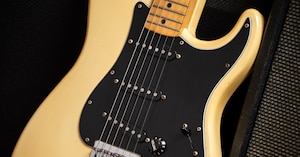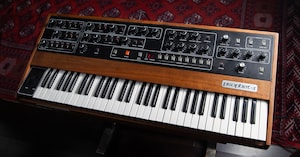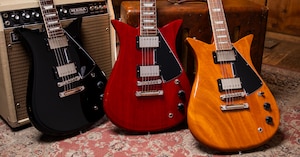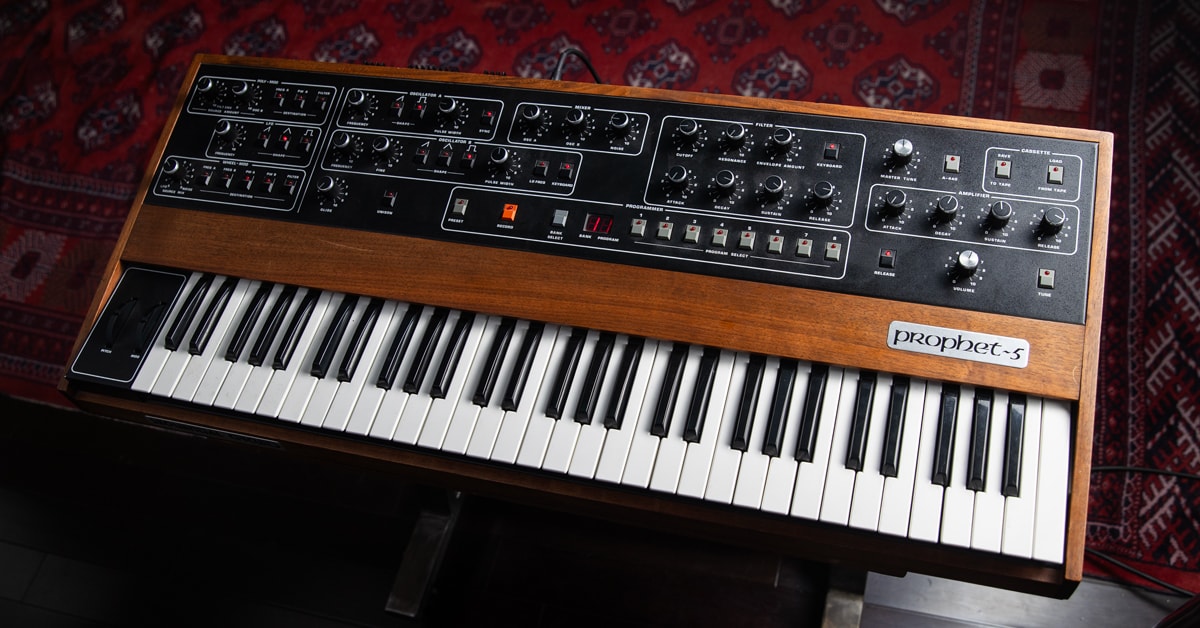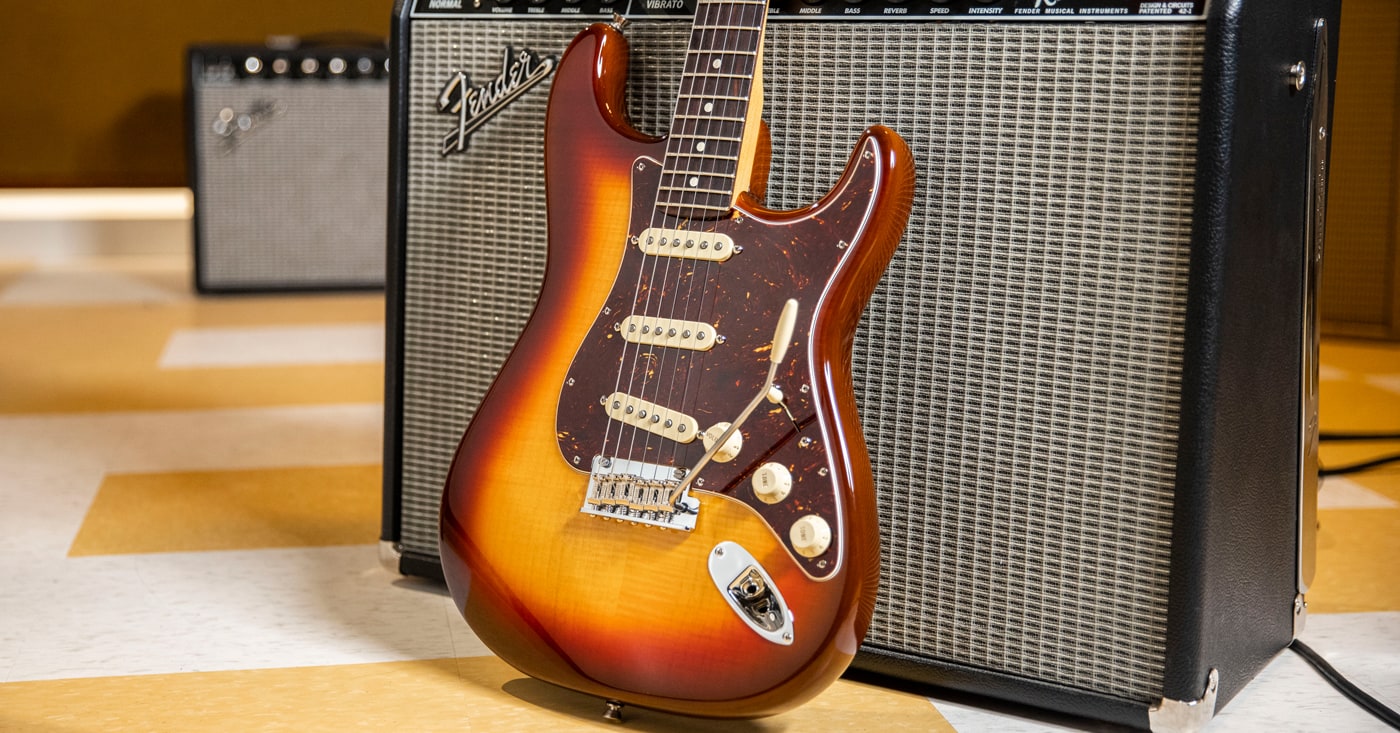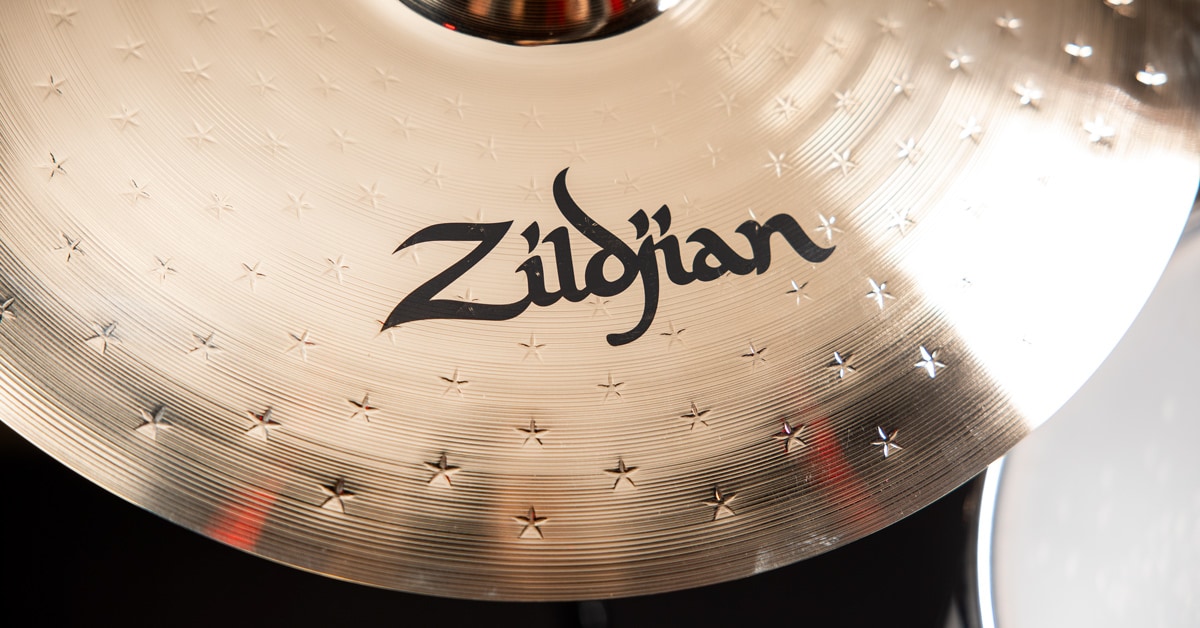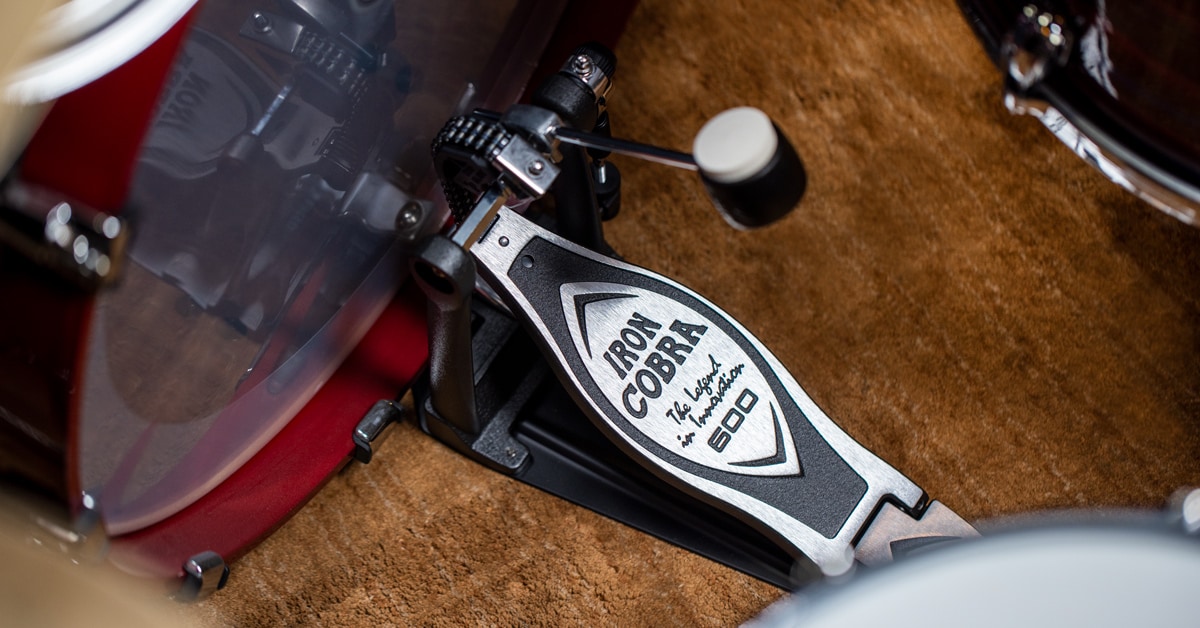Non-drummers might look at a bass drum pedal and think, "Easy … you just step on the pedal and the drum goes 'boom!'" But there is a lot more to a kick pedal than just that, both in terms of historical development and the various mechanical elements that transform that simple act of bouncing your foot up and down to the satisfying "thump" of a well-tuned (see our article "How to Tune Your Drums" for that) bass drum.
In this article, we're going to explore a little of that history and dive a little more deeply into the mechanisms that make up the modern kick drum pedal, as well as look at the strengths and weaknesses of each type of construction when it comes to your personal playing style. Then, we'll wrap it all up with a look at the pedals we think are the best choices for players at every level and any budget.
Table of Contents
Origins of the Bass Drum Pedal
Bass Drum Pedal Mechanics
What Different Drive Mechanics Are Used in Bass Drum Pedals?
Comparing Drum Pedal Drive Types
Bass Drum Pedal Footboards
Bass Drum Pedal Cam Styles
Bass Drum Pedal Buying Guide
Great Value and Beginner Drum Pedals
DW 3000 Series Bass Drum Pedals
TAMA Iron Cobra 200 Series Bass Drum Pedals
Pearl P930 Chain Drive Series Bass Drum Pedals
Awesome Mid-Tier Bass Drum Pedals
DW 5000 Series Turbo Drive Bass Drum Pedals
TAMA Iron Cobra 600 Series Bass Drum Pedals
Pearl Eliminator Redline Chain Drive Series Bass Drum Pedals
High-End Bass Drum Pedals
DW Machined Direct Drive Series Bass Drum Pedals
TAMA Dyna-Sync Series Bass Drum Pedals
Yamaha DFP9D Direct Drive Bass Drum Pedals
Top-Tier Bass Drum Pedals
DW Machined Direct Drive Series Bass Drum Pedals
TAMA Limited-Edition 50th Anniversary Iron Cobra Power Glide Series Bass Drum Pedals
Laying Down the Beat
Origins of the Bass Drum Pedal
After the Civil War, popular marching bands which played concerts (which was a thing in those times) began to downsize from separate bass, snare and cymbal players to a single drummer in the latter part of the 19th century and the first decade of the 20th. This was so they could play smaller venues with fewer people. Bass drum pedals, when they were used, were generally home-built devices composed of wood, rope, pulleys, baling wire and the desire to not have to grow a third arm to beat the drum. Some of these were seriously convoluted contraptions. They would do things like hang a pendulum-style beater from the top of the bass drum and pull on it with a rope attached to a wooden pedal with the only return being controlled directly by the drummer's foot. These pedals were so dicey that most drummers preferred to do what was called "double drumming," where the bass drum was raised up enough that they could simply alternate between the snare and the bass drum with standard drum sticks.
It was the Ludwig brothers, William and Theobald, who created the first commercial, patentable, usable pedal in 1909, giving them a kick (sorry, couldn't resist) start over other manufacturers. With a spring return and enough control to play more complex patterns, this design occurred just as a craze for ragtime was peaking. This, along with the beginnings of what would become New Orleans-style jazz needed a faster, more precise and controllable bass drum. For their first several years of operation, Ludwig & Ludwig were strictly a pedal company, and their development into a full-fledged drum and percussion manufacturer is a story for another time.
Other companies jumped into the pedal market, but Ludwig had enough of a head start that they were dominant for most of the next 50 years, introducing the Speed Pedal in 1934, followed closely by the Super Speed Pedal in 1936 and, after the end of the Second World War, and with a new company, William F. Ludwig introduced the Speed King Pedal in 1950—a design which has lasted to the present day.
But enough history—let's get to the mechanics of the thing and look into how the deceptively simple bass drum pedal works its magic.
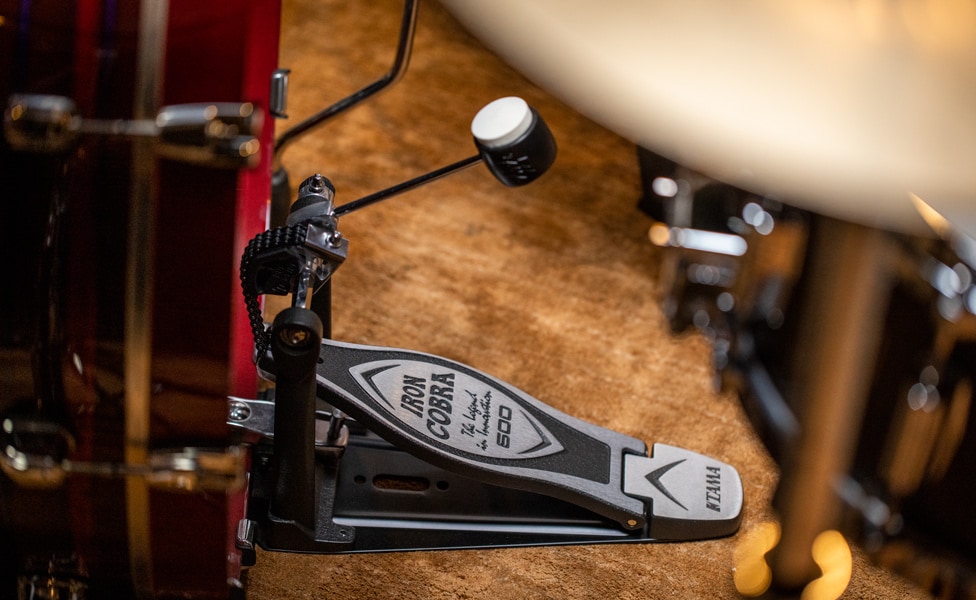
Bass Drum Pedal Mechanics
At the simplest, there are three basic components that make up a kick drum pedal—the drive system, the footboard and the cam setup. The secondary components are essentially ways to adjust the relationship between those three primary elements. So, let's take a look at them, one at a time, starting with the heart of the bass pedal—the drive system.
What Different Drive Mechanics Are Used in Bass Drum Pedals?
When it comes to drive mechanics for kick drum pedals, there are three basic ways that are in common use. In order of development, these are: belt drive, direct drive and chain drive. Each has its advantages and disadvantages, which we'll break down shortly.
Belt (sometimes called strap) drive, where a belt or strap of some sort connects the pedal's footboard to the beater mechanism, was a part of the Ludwig brother's original design. The material used can vary from stiff, waxed string (which the first Ludwig pedals used) to a strip of leather or, in some modern designs, a woven material similar to what's used on conveyor belts.
Direct drive uses a single stiff link between the footboard and the beater assembly, usually a metal rod or a strip of spring steel. Direct-drive bass drum pedals have either a linear cam (see discussion of cams below) or sometimes no cam between the footboard and beater, so the action of your foot is transferred directly to the beater with little to no intermediary mechanical linkage. The first widely available direct-drive bass drum pedal was the Ludwig Speed King in 1950 (William F. Ludwig, btw, was a skilled symphonic percussionist and one of the founders of the National Association of Rudimental Drummers, so he would have really appreciated you getting your paradiddles on).
The chain-drive kick drum pedal was invented in the late 1970s, when some enterprising (but, as far as we've been able to determine, unnamed—if you know, please let us know) technician at a New York drum shop cobbled together a mechanism that used a bit of bicycle chain to combine the speed and precision of a direct-drive system with the feel and controllability of a belt-drive one.
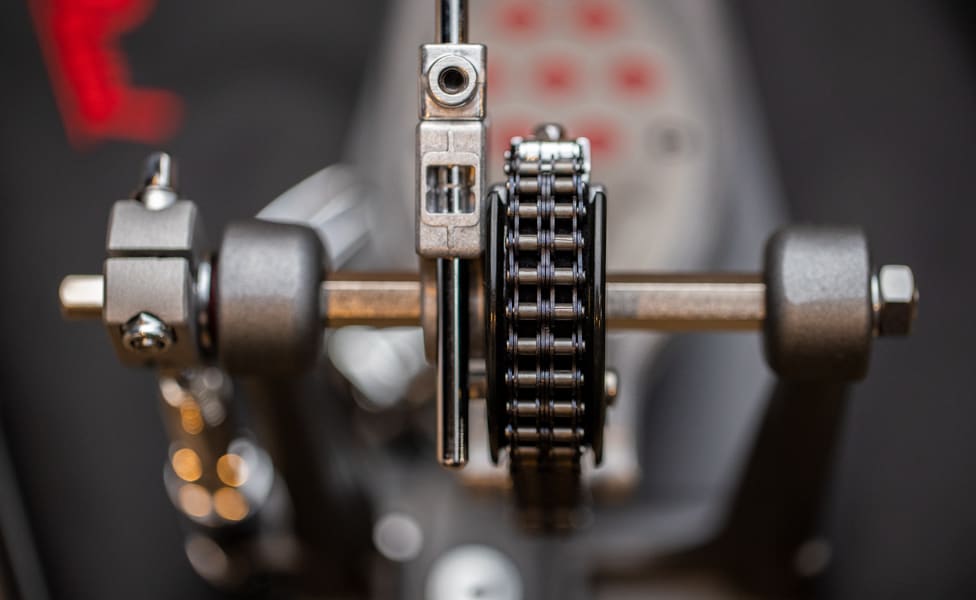
Comparing Drum Pedal Drive Types
One thing to bear in mind while contemplating this little table is that, like so many things musical, your choice of gear relies on your personal taste and playing style so that, like much of life, these are suggestions more than hard and fast rules.
|
Drive type |
Advantages |
Disadvantages |
|
Belt drive |
Easier control for heel/toe and heel-up playing |
Less speed and precision, especially for heel-down techniques |
|
Direct drive |
Very fast and precise response, excellent for heel-down players |
Stiffer feel, may be harder to control subtle techniques like push/pull and heel/toe |
|
Chain drive |
Excellent compromise of speed, precision and control |
Not quite as fast and precise as direct drive, not as "organic" a feel as belt drive |
Bass Drum Pedal Footboards
When it comes to the "pedal" part (aka the footboard) of a bass drum pedal, you get two basic choices—standard and longboard. What's the difference? The standard footboard has a hinge at the rear of the pedal so a short section stays flat on the floor. It isn't part of the playing surface and is mostly used as a place to rest your heel.
A longboard pedal doesn't have that hinged section, so the entire footboard is playing surface. Why would you want over the other? A long playing surface makes toe/heel, push/pull and similar techniques easier. Plus, if you have larger feet, the longboard is generally more comfortable since you can play without having your toes scrunched up against the beater.
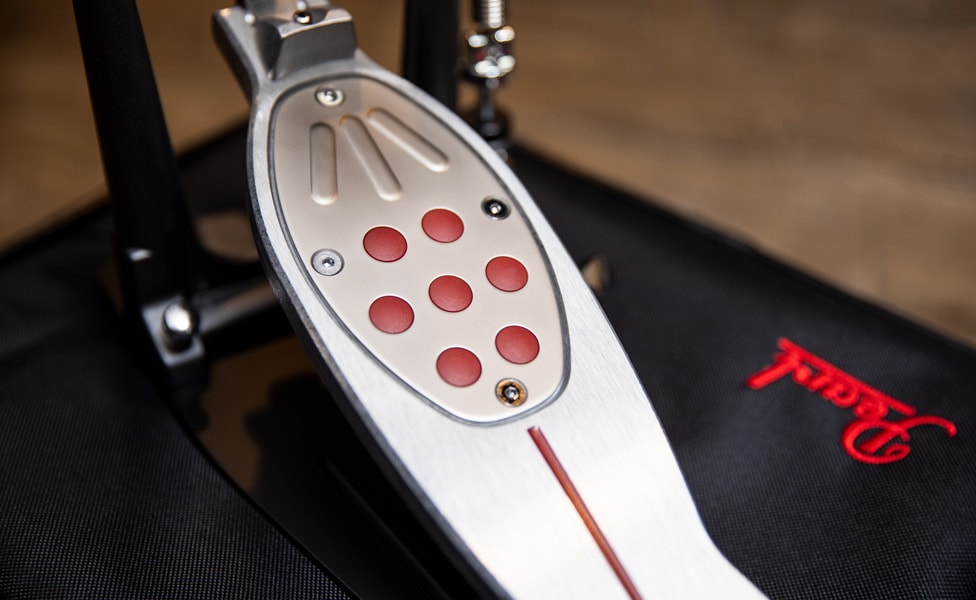
Bass Drum Pedal Cam Styles
One of the key contributors to a kick drum pedal's action and feel is the cam setup. There are two basic styles of cam—linear and offset. A linear cam has a constant radius, making it perfectly round. This means the speed of the beater is always in a constant relationship to the speed of your foot. An offset cam has a varying radius, so that can make the speed of the beater accelerate as it gets closer to the bass drum head.
Again, the question: Why would you want that? First of all, it makes the pedal feel lighter at the beginning of your stroke. Then, speeding up as the radius of the cam decreases, it feels a little heavier and delivers more power to the head of the beater. Some pedals come with interchangeable or adjustable cams so you can dial in the exact feel you want.
Like so many things in music, there's not a right or wrong here, just a matter of personal taste and how you want your bass drum pedal to feel. The best approach here is to visit the drum department at your local Guitar Center store and audition a number of pedals. If you need help adjusting them to really get a feel for the pedals, our knowledgeable associates will be glad to help.
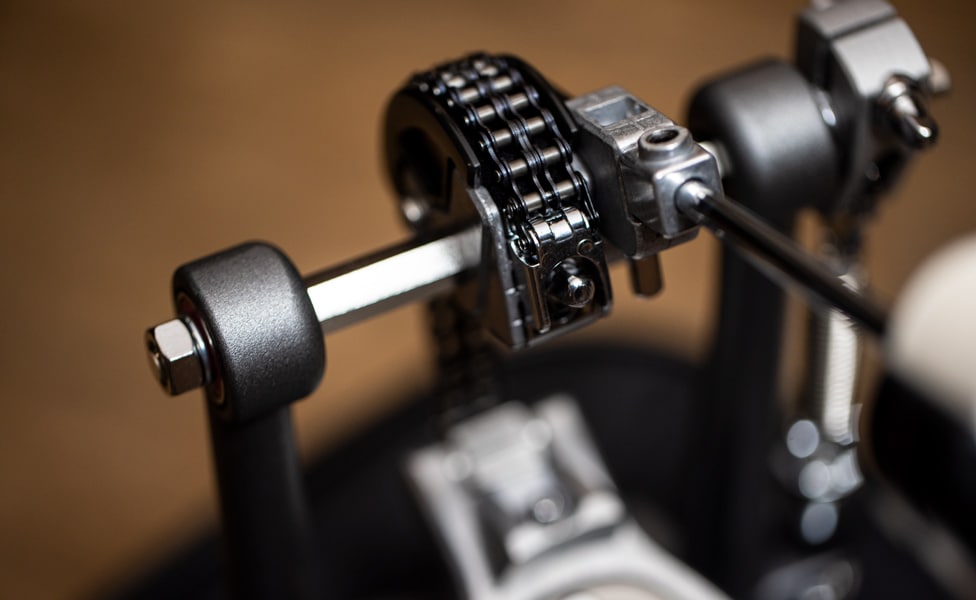
Bass Drum Pedal Buying Guide
So, now that you're a little more familiar with the main part of a bass drum pedal, let's look over what we recommend, from entry level to top tier, and help you decide what is the best bass drum pedal for you.
Great Value and Beginner Bass Drum Pedals
We'll start with three of the bass drum pedals that we feel offer exceptional value for beginning drummers or players on a budget. These pedals might give up a bell and whistle or two in adjustability, but they are all solid performers and are built to last.
DW 3000 Series Bass Drum Pedals
The DW 3000 series bass drum pedal is available as a single or double kick pedal. This is a dual-chain-drive pedal that features DW's Turbo-Cam offset cam for fast action. A dual-bearing rocker allows the adjustment spring to follow the pedal through its entire stroke, and a dual adjustable toe clamp makes sure that it stays securely connected to your bass drum hoop. It includes a dual-sided beater and, because like socks, remote controls and guitar picks, they have a tendency to drop through wormholes, a securely attached drum key for making those critical adjustments.
Bottom Line: A great point of entry into the DW-verse, this stable, versatile pedal is sure to please.
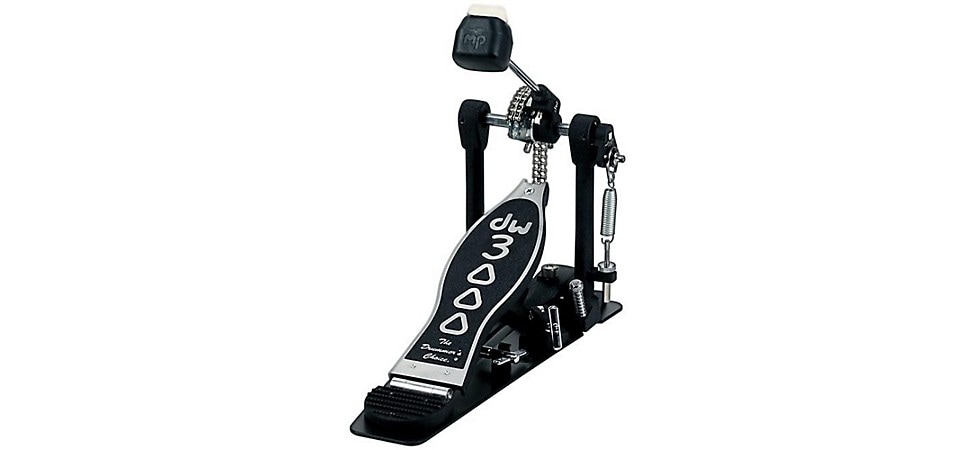
Pictured: DW 3000 Series Single Bass Drum Pedal
TAMA Iron Cobra 200 Series Bass Drum Pedals
The TAMA Iron Cobra 200 is also available as a single or dual pedal. This single-chain-drive pedal features TAMA's Power Glide offset cam and Spring Tight tension rod to ensure quick, powerful beater response and a consistent beater return. It also features TAMA's Para Clamp hoop clamp for an extra secure attachment to your bass drum.
Bottom Line: The Iron Cobra 200 delivers premium performance at the best price in this category.
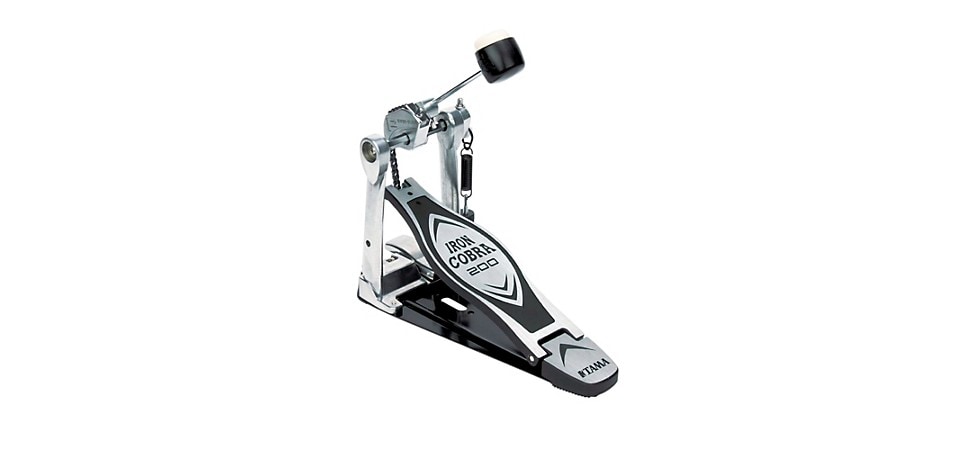
Pictured: TAMA Iron Cobra 200 Series Single Bass Drum Pedal
Pearl P930 and Chain Drive Series Bass Drum Pedals
The Pearl P930 is a single-chain longboard pedal with interchangeable cams—a unique feature at this price. Available in single or double pedal versions, this is probably the most adjustable of these high-value pedals. Borrowing advanced features from Pearl's Demon Drive pedals, like the Click-Lock spring tension system and the patented Powershifter system, the P930 is a rocker's delight.
Bottom Line: If you want to heel/toe and/or have larger feet, this highly adjustable longboard pedal will be quick and comfortable.
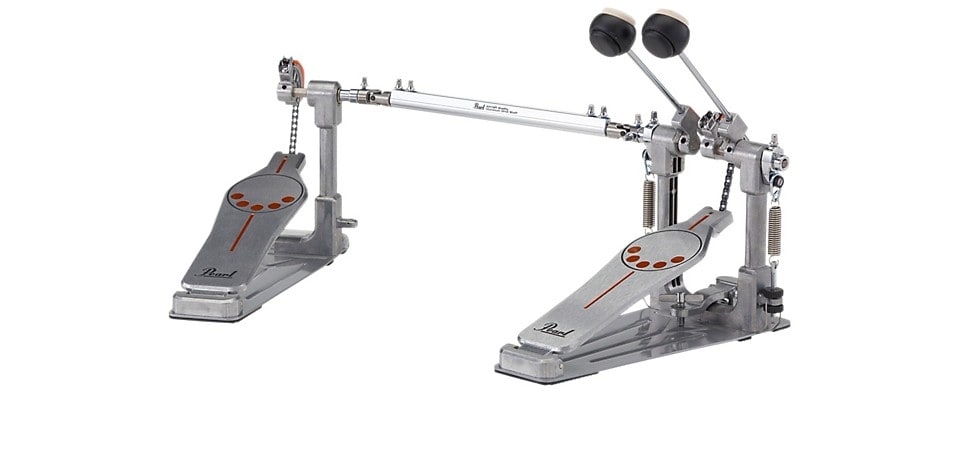
Pictured: Pearl P932 Double Bass Drum Pedal
Awesome Mid-Tier Bass Drum Pedals
Stepping up to the next level of kick drum pedal, these mid-range pedals up the adjustability and expand the feature set for greater versatility.
DW 5000 Series Turbo Drive Bass Drum Pedals
The DW 5000 Series TD4 double kick pedal has been considered a standard since its debut. With DW's Turbo Drive linear cam, it delivers quick, even response. Packed with patented DW features like the Tri-Pivot hoop clamp and Delta ball-bearing hinge, this is one of the smoothest pedals out there.
Bottom Line: Can you say fast and smooth?
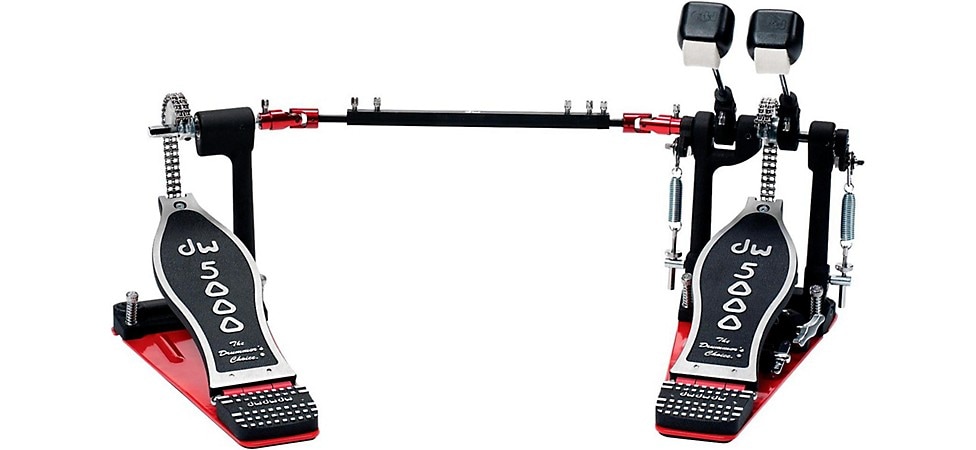
Pictured: DW 5000 Series TD4 Turbo Drive Double Bass Drum Pedal
TAMA Iron Cobra 600 Series Bass Drum Pedals
The TAMA Iron Cobra 600 Series double bass drum pedal (also available as a single pedal) features a dual-chain drive with TAMA's innovative reversible Duo-Glide cam system for an easy change for linear to offset action. It also includes the Para Clamp hoop mount and Spring Tight systems we mentioned previously, plus a ball-bearing spring rocker and a redesigned heel plate. It's super fast and readily adjustable.
Bottom Line: If you're already in the TAMA ecosystem, this one is an excellent upgrade.
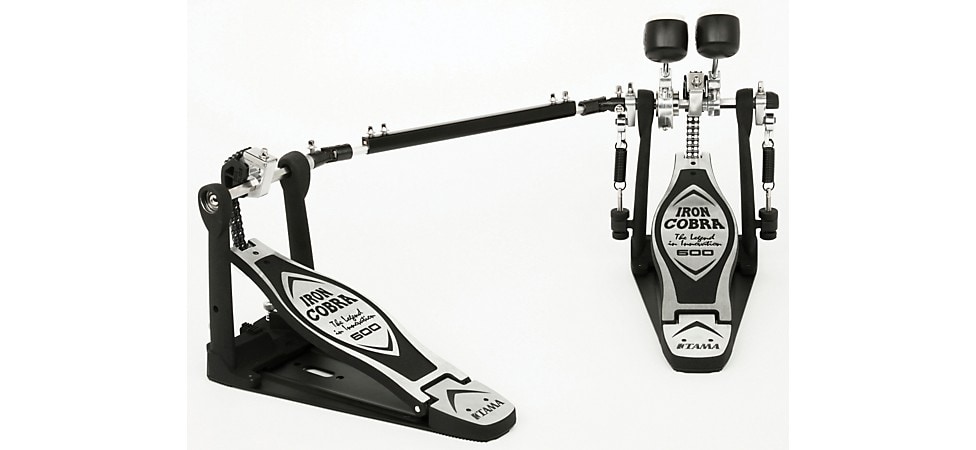
Pictured: TAMA Iron Cobra 600 Series Double Bass Drum Pedal
Pearl Eliminator Redline Chain Drive Series Bass Drum Pedals
The Pearl Eliminator Redline chain-drive pedals (both single and double) bring together the best features of their Eliminator and Demon Drive pedals for a fast, smooth action. Boasting four swappable cams, NiNja ball bearings—borrowed from high-end skateboards—a Power Shift adjustable footboard and Pearl's super smooth Floating Spring Pendulum, the Eliminator Redline is all about adjustability.
Bottom Line: If you like to really dial it in, this one has all the tweaks.
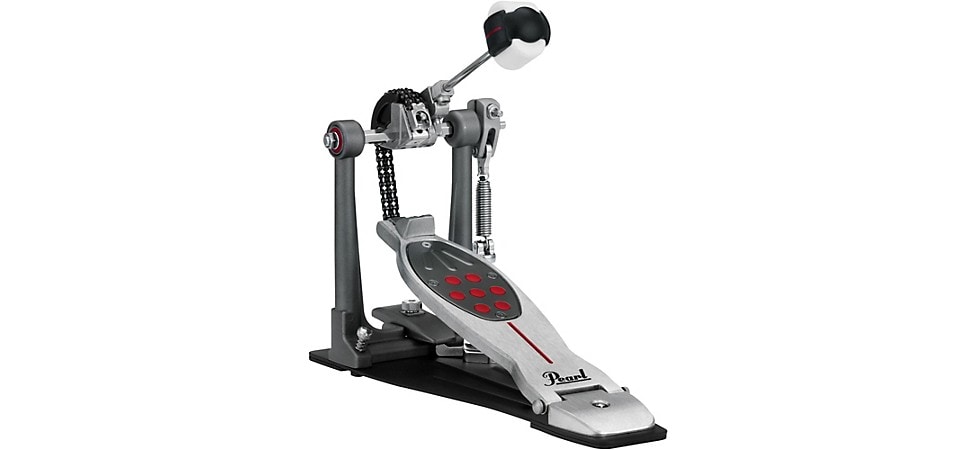
Pictured: Pearl Eliminator Redline Single Bass Drum Pedal
High-End Bass Drum Pedals
These next two categories are where things really start to get serious. These top-of-the-line bass drum pedals offer the maximum in smoothness, power and speed.
DW Machined Direct Drive Series Bass Drum Pedals
The DW Machined Direct Drive bass drum pedals (single and double) are milled from solid aircraft aluminum stock at DW's factory in Oxnard, California. Designed to be lightweight, exceptionally responsive and almost infinitely adjustable, the direct-drive system is incredibly quick, thanks in part to the smooth bearings on the floating beater rotor. And speaking of the beater, the weight of the beater head is adjustable with removable weights to really dial in your preferred feel. You can also adjust footboard height independently of beater angle. For many drummers, this is their dream pedal.
Bottom Line: Light, fast, responsive and stylish. This one is like a fine sports car, except it's easier to maintain.
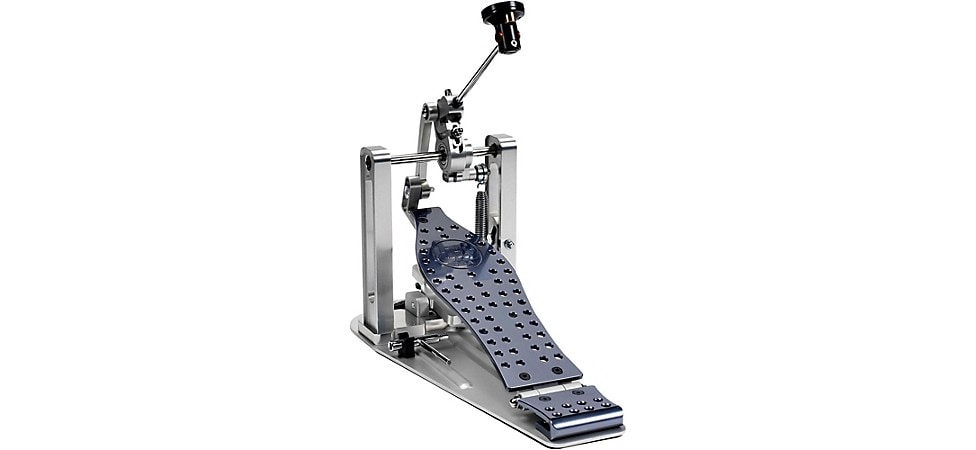
Pictured: DW Machined Direct Drive Single Bass Drum Pedal
TAMA Dyna-Sync Series Bass Drum Pedals
The TAMA Dyna-Sync bass drum pedals (double and single) boast TAMA's unique Dynamic Synchronization (Dyna-Sync) system. This system is designed to combine the speed and power of a direct-drive pedal with the more organic feel of a chain-drive pedal. The adjustable cam enables you to carefully dial in the exact power curve and feel that works best for you, while maintaining the benefits that a direct-drive system offers.
Bottom Line: This one's for the drummer who likes the speed and impact of a direct-drive pedal, but wants that subtly organic feel of a flexible drive system like chain- or belt-drive.
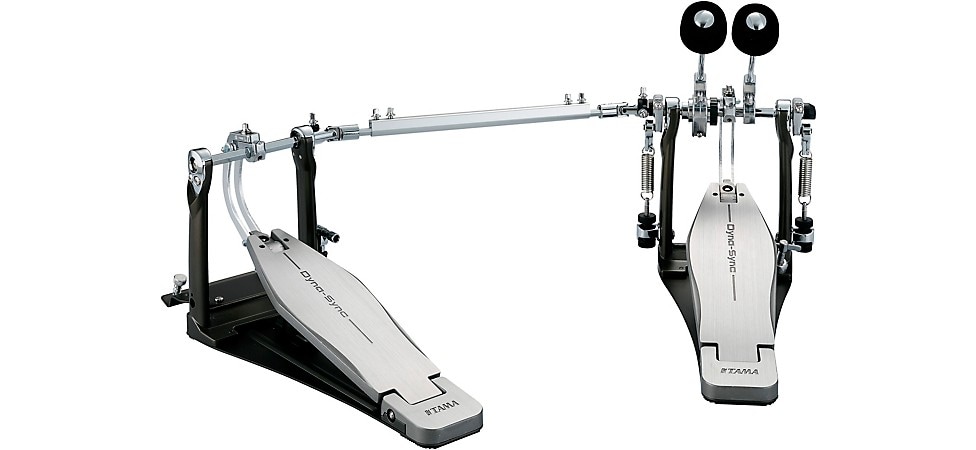
Pictured: TAMA Dyna-Sync Double Bass Drum Pedal
Yamaha DFP9D Direct Drive Bass Drum Pedals
Yamaha's DFP9D Direct Drive double bass drum pedal offers a wide range of adjustability and includes a number of Yamaha innovations. The direct-drive linkage is adjustable for three different positions, enabling you to find the feel you want, and you get independent beater and footboard angle adjustments. The footboard features a ball-bearing linkage to the drive component for ultrasmooth action. Like all the pedals in this class, the level and precision of available adjustments is spectacular.
Bottom Line: The super smooth action of this pedal will find favor with drummers who want added subtlety.
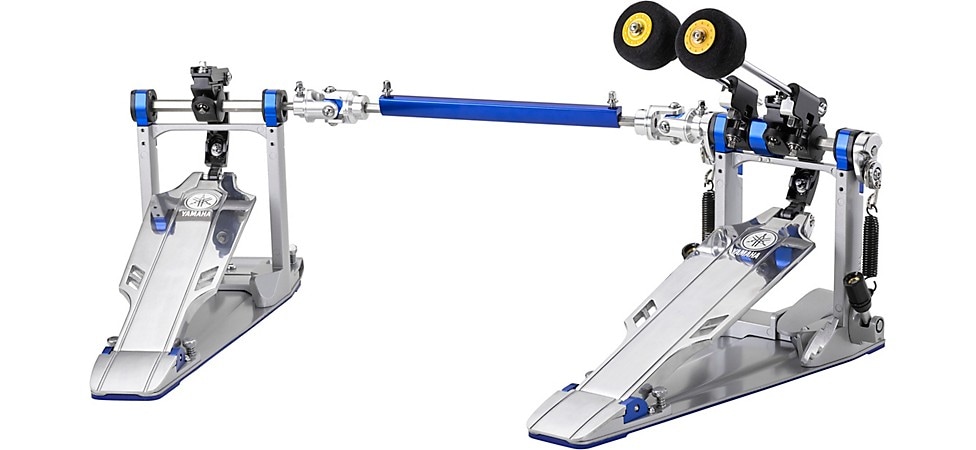
Pictured: Yamaha DFP9D Double Bass Drum Pedal
Top-Tier Bass Drum Pedals
These last two pedals take a step beyond the normal with a touch (or more) of added flair. Some may say it's gliding the lily, while others believe that over the top should be the destination.
DW Colorboard Machined Direct Drive Bass Drum Pedals
Love the idea of the DW Machined Direct Drive bass drum pedals, but think that they need a little extra flash? Get all that speed and adjustability with a big splash of color on the DW Colorboard Machined Direct Drive Double Bass Pedal with a cobalt footboard (offered in both single and double pedal variations), then look down at your feet while you're playing and remember that blue-shift means faster!
Bottom Line: It's a bling thing on a really great kick pedal. If life is a fashion risk, go for it.
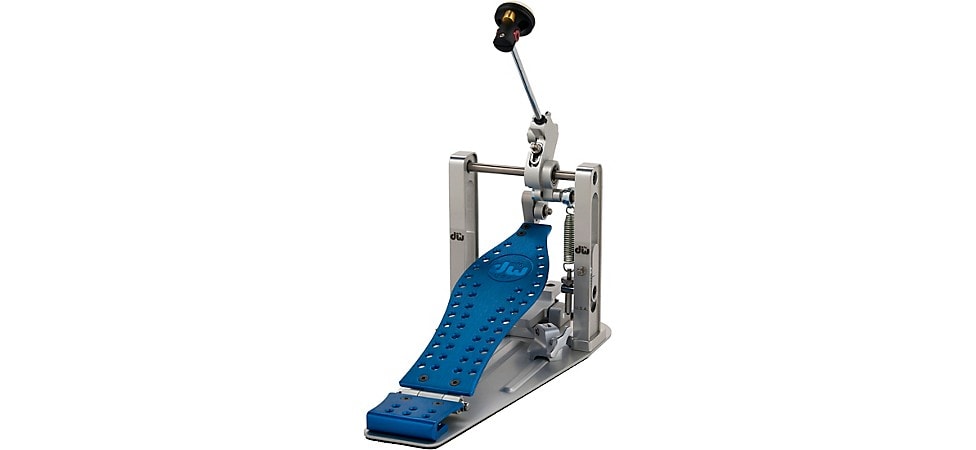
Pictured: Yamaha DFP9D Double Bass Drum Pedal
TAMA Limited-Edition 50th Anniversary Iron Cobra Power Glide Series Bass Drum Pedals
It's TAMA's 50th anniversary, and what better way to mark it than with these limited-edition versions of the spectacular Iron Cobra Power Glide pedal we previously discussed. Available in both single- and double-pedal versions, these special commemorative editions boast spectacularly trippy graphic treatments suitable for remembrance of 1974, when TAMA got its start. Decorated with Psychedelic Rainbow or Coral Swirl finishes, you might want to hang them on your wall for display, except that they're just too much fun to play.
Bottom Line: These are pretty much guaranteed to sell out and become collectible, but they're also an incredibly good kick pedal, so why not get the best of both worlds?
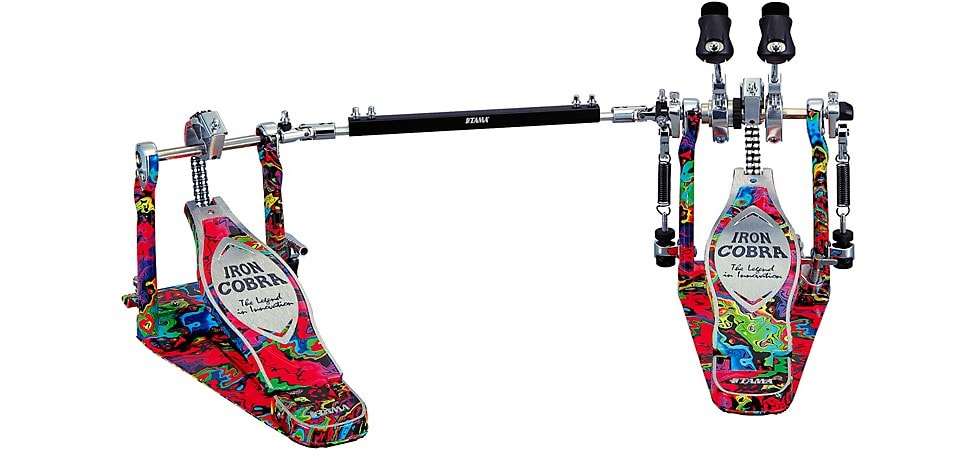
Laying Down the Beat
So, there you go—all the way from your first good bass drum pedal to ones that add those extra layers of playability and adjustability that make your kit truly yours. Once again, we'll remind you that the absolute best way to decide which one is for you is to head to your nearest Guitar Center store and get hands (or feet, in this case) on so you can experience the subtle, and not-so-subtle differences for yourself. There is no substitute, really, for lining up several and trying the out at the same time to zero in on the one that fits you best. Or, if you can't get to a store, one of our knowledgeable Gear Advisers at our Call Center can certainly get you pointed in the right direction.

